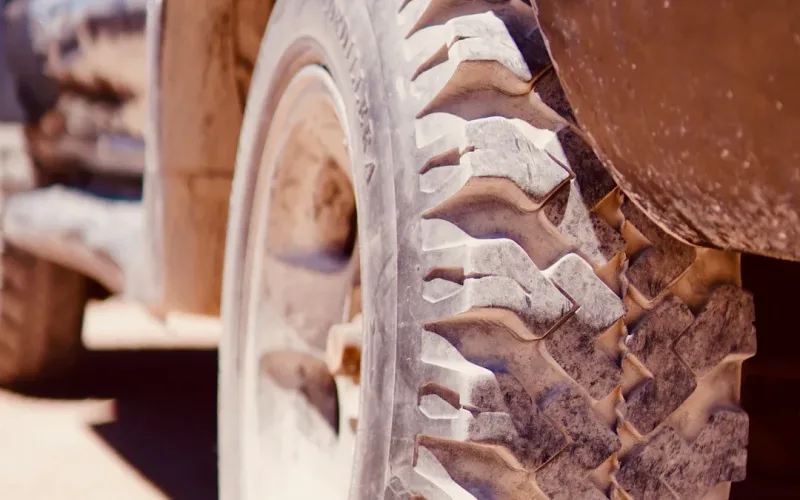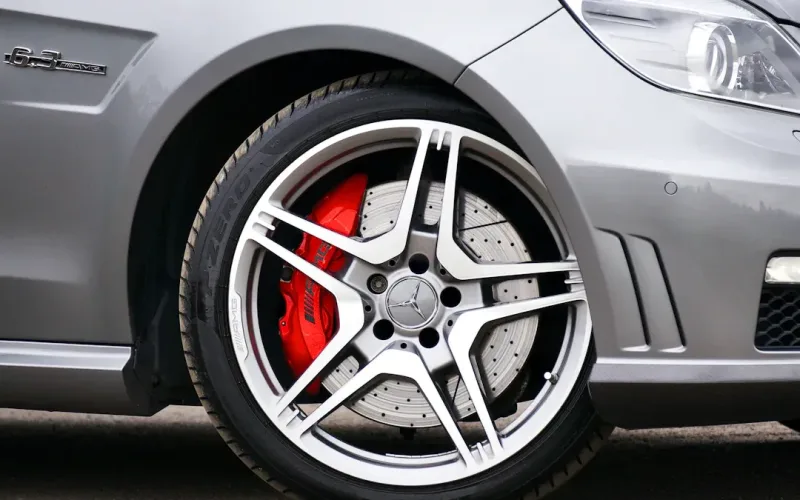

admin1
August 16, 2025
Air Down Tool Made Easy for Tire Pressure
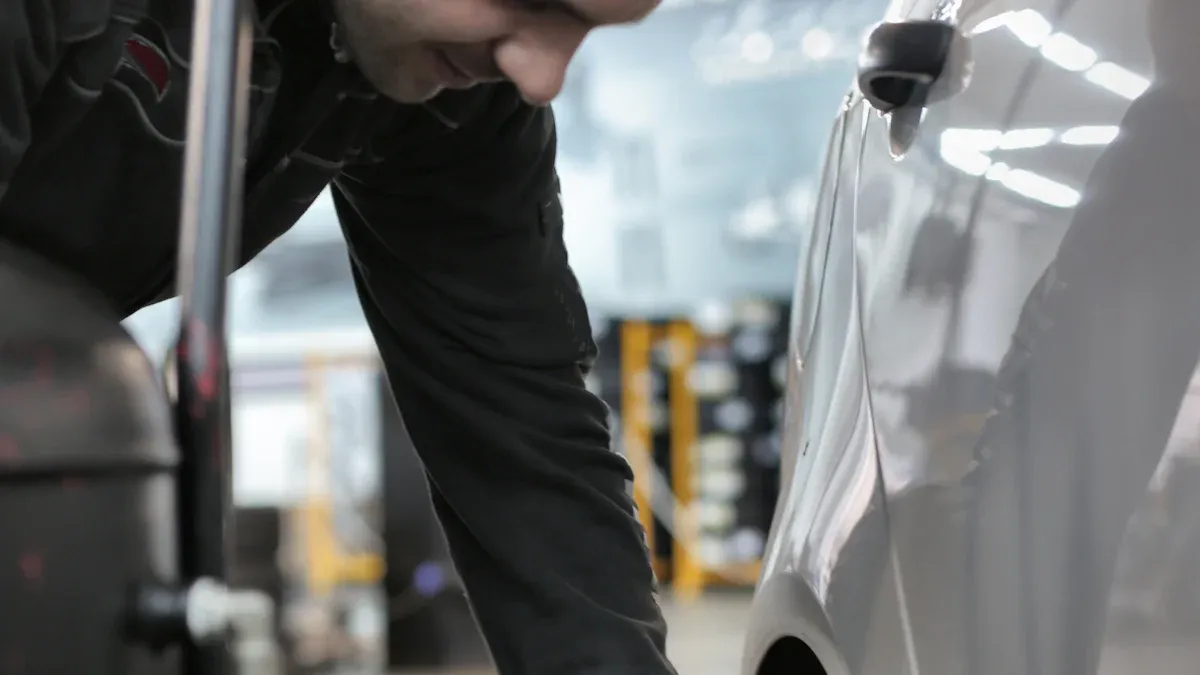
You want your ride to feel smooth and safe, right? The air down tool helps you take control of your tire pressure. When you lower the pressure in your tire, you can get improved traction, especially on sand, gravel, or rough roads. Just attach the air down tool to your tire valve. You will hear air escape as you watch your tire pressure drop. Check with a gauge to make sure you reach the best PSI for your tire. With the right air down tool, you keep your tire strong and ready for any adventure. Your tire will thank you for the extra care.
What Is an Air Down Tool?
Definition and Purpose
You might wonder what an air down tool does for your tire. This handy device, sometimes called a tire deflator, attaches right to your tire valve. When you use it, you can quickly release air from your tire and lower the pressure to the level you want. The main job of an air down tool is to help you adjust your tire pressure for better performance. If you drive on sand, gravel, or rocky trails, you need more grip. Lowering your tire pressure with an air down tool increases the contact area between your tire and the ground. This means your tire can grab the surface better, giving you more traction and a smoother ride. You also lower the chance of getting a puncture because your tire can flex and move over rough spots. Some air down tools, like the JACO RapidFlow Tire Deflator, can drop your tire pressure by 15 PSI in less than 20 seconds. That saves you time and keeps your tire ready for action. You get control, comfort, and safety every time you use an air down tool.
Tip: Always check your tire pressure with a gauge after using an air down tool. This helps you hit your target PSI and keeps your tire in top shape.
Types of Air Down Tools
You have a few choices when it comes to air down tools. Each type works a little differently, but they all help you lower your tire pressure. Here’s a quick look at the main types:
| Tool Type | Mechanism Description | Typical Use / Feature Highlights |
|---|---|---|
| Manual Tire Deflator | You twist or press to release air from the tire valve. | Simple, easy to use, good for single tires. |
| Automatic Tire Deflators | These attach to the tire valve and stop releasing air when your tire hits the set PSI. | Fast, accurate, great for airing down multiple tires at once. |
| Digital Tire Deflator | Uses a digital gauge to show exact tire pressure as you release air. | Precise, easy to read, perfect for fine-tuning tire pressure. |
If you want speed and accuracy, automatic tire deflators are a smart pick. You set your target PSI, attach them to each tire, and let them do the work. They stop automatically when your tire reaches the right pressure. Manual tire deflators give you more control, but you need to watch the gauge closely. Digital tire deflators show you the exact pressure, so you never guess. No matter which air down tool you choose, you make tire pressure adjustment easy and safe.
Why Airing Down Matters for Tire Pressure

Benefits of Airing Down
If you love off-roading, you know how important it is to keep your tires ready for any challenge. Airing down gives you a big advantage when you leave the pavement. When you lower your tire pressure, your tire spreads out and covers more ground. This larger contact patch helps your tire grip loose surfaces like sand, mud, or gravel. You get improved traction, which means you can drive over tough spots without getting stuck.
Airing down also makes your ride smoother. Lower tire pressure lets your tire flex and absorb bumps from rocks or roots. You feel less shaking inside your vehicle. Experts have seen this in real life, like in the Dakar Rally, where racers air down to avoid getting stuck. Studies show that airing down can cut your risk of getting stuck in sand by up to 50%. Your tire can even flex around sharp rocks, which helps prevent damage and punctures.
Here are some top benefits of airing down:
- More grip on rocky, muddy, or sandy trails
- Smoother ride because your tire absorbs shocks
- Less chance of tire damage from sharp objects
- Better control and stability on uneven ground
- Less trail erosion since your tire spreads your vehicle’s weight
Airing down is a key part of tire pressure management for off-roading. It helps you get the most out of your tires and boosts your off-road performance.
When to Air Down Your Tires
You might wonder about the right conditions for airing down. Off-roading experts recommend airing down when you drive on rough dirt roads, loose terrain, mud, sand, or rocky paths. These surfaces make it hard for regular tire pressure to keep you moving. Airing down increases your tire’s contact area, so you get more grip and a smoother ride.
Knowing how much to air down depends on your terrain and vehicle. For sand, you can drop your tire pressure to about 20-25 psi. On rocky trails, you might go to 35-40 psi. Always check your tire and vehicle setup before you decide how much to air down. Here’s a quick guide:
| Terrain Type | Recommended Tire Pressure (psi) |
|---|---|
| Firm dirt/gravel | 50 front / 55 rear |
| Uneven surfaces | 40 front / 45 rear |
| Rough/rocky surfaces | 35 front / 40 rear |
| Sand | 25 front / 30 rear |
| Soft deep sand | 20 front / 25 rear |
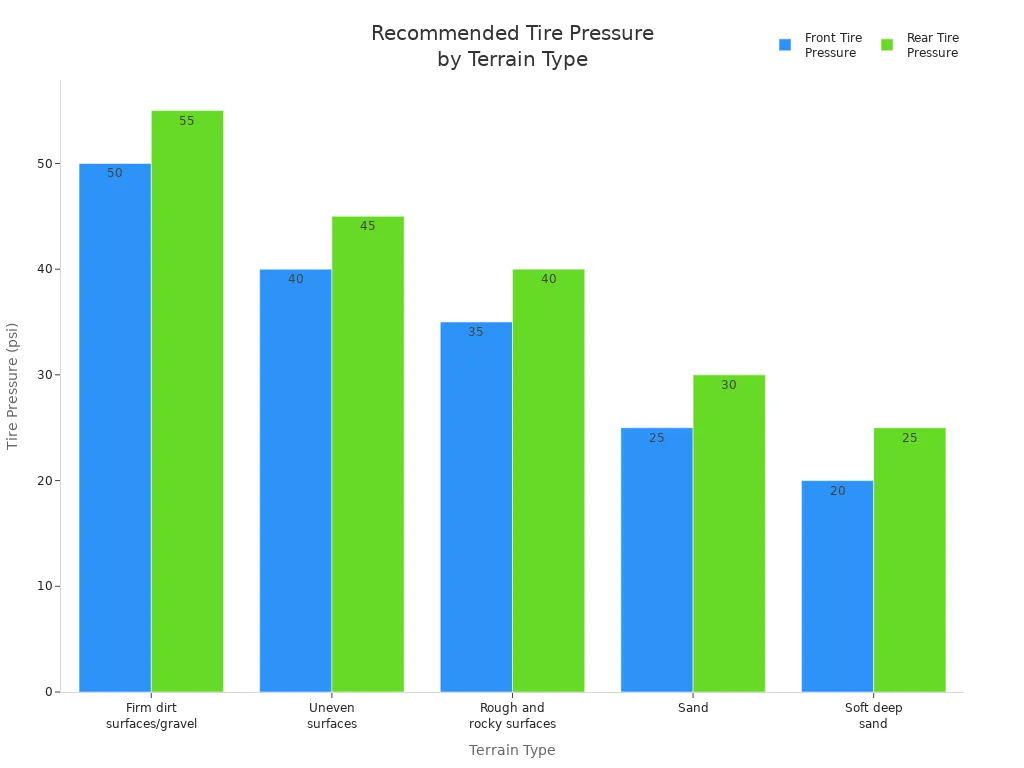
You should never air down for regular road driving. Low tire pressure on pavement can cause damage and make steering hard. Always return to your ideal tire pressure when you finish off-roading. Remember, the right conditions for airing down are off-road adventures where you need extra grip and comfort.
Tip: Always use a gauge to check your tire pressure after airing down. This keeps your tires safe and ready for the next adventure.
Step-by-Step Guide to Airing Down with an Air Down Tool
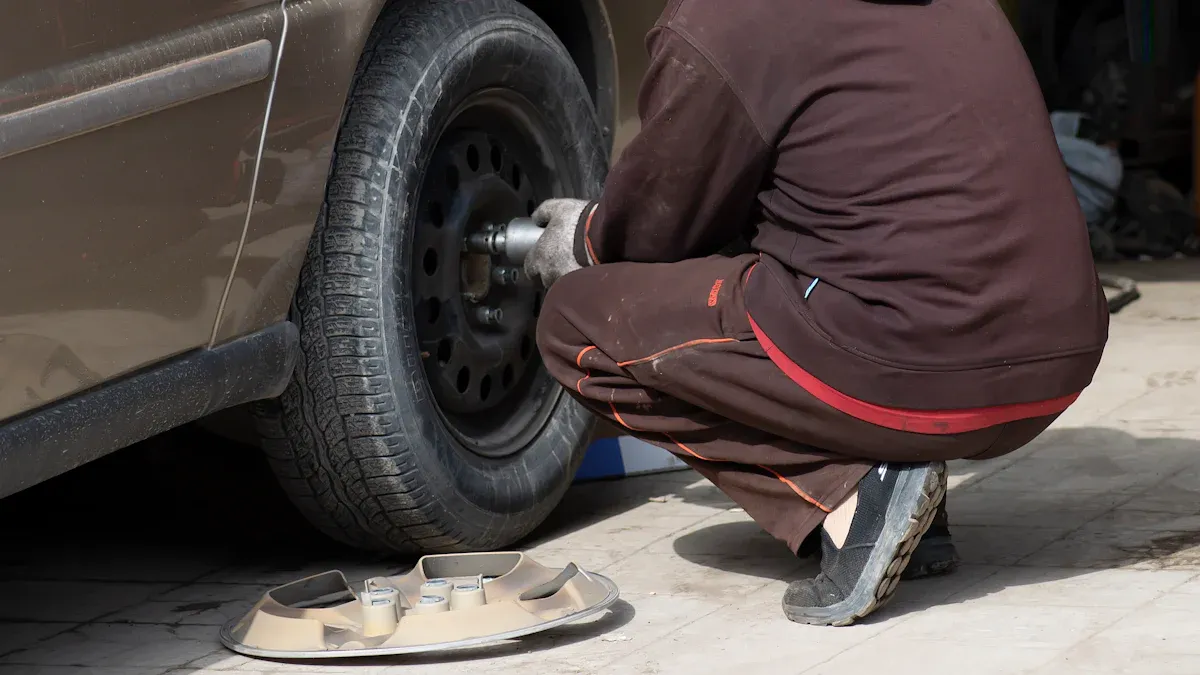
Preparation: Tools, Safety, and Checking Current Pressure
Before you start airing down, you need to get your tools ready and think about safety. You want to make sure you have everything you need for a smooth process. Here’s a quick table to show you the essential tools and how each one helps:
| Tool | How It Helps You |
|---|---|
| Tire Pressure Gauge | Lets you check your tire pressure before and after airing down. |
| Tire Inflator/Deflator Tool | Helps you let air out of your tire in a controlled way. |
| Air Compressor | Lets you put air back in your tire when you finish off-roading. |
| Valve Cap Remover | Makes it easy to take off the valve cap so you can use your air down tool. |
You also want to follow some important safety steps. Tire manufacturers recommend these precautions to keep you safe:
- Wear safety goggles or a face shield when working on your tire.
- Check your rims and wheels for cracks or sharp spots. Smooth out any rough areas.
- Never over-deflate your tire. Too little air can make the tire bead come off the rim or cause a blowout.
- Always use a trusted tire pressure gauge to check your tire pressure.
- Only use non-flammable lubricants if you need to work on the tire bead.
- Never use flammable materials to seat beads.
- Always re-inflate your tires before driving on paved roads.
Start by checking your current tire pressure. Use your tire pressure gauge to get a reading. Write down the number so you know how much air you need to let out. This step helps you avoid letting out too much air.
Tip: Always inspect your tire for damage before you start airing down. A damaged tire can be dangerous, especially at low pressure.
Attaching and Operating the Air Down Tool
Now you’re ready to use your air down tool. This part is simple, but you want to do it right for the best results. Here’s how you do it:
- Remove the valve cap from your tire.
- Attach the air down tool to the valve stem. Make sure it fits snugly so no air leaks out.
- If you have a manual tool, twist or press it to start letting air out. If you use an automatic tool, set your target PSI before attaching.
- Watch the pressure drop. Some tools have a built-in gauge so you can see the number as you go.
- If you use a quick-release deflator, like the JACO RapidFlow, you can unscrew and capture the valve core for faster air release. This gives you more control over how fast the air comes out.
You want to use the right tool for your needs. Quick-release deflators work great if you want to air down all four tires fast. Manual tools give you more control if you want to go slow and steady.
Note: Always follow the instructions that come with your air down tool. Each tool works a little differently, so check the manual if you’re not sure.
Monitoring Pressure and Achieving Desired PSI
Airing down is not just about letting air out. You need to keep an eye on your tire pressure the whole time. Here’s a step-by-step guide to airing down and hitting your target PSI:
- Use your tire pressure gauge to check the starting pressure.
- Attach your air down tool and begin to let air out slowly.
- Stop every few seconds to check the pressure with your gauge. If your tool has a built-in gauge, watch it closely.
- Aim for the right PSI for your terrain. For example, if you’re driving on sand or loose gravel, you might want 12-15 psi. On rocky trails or mud, 15-20 psi works well. Snow also needs lower pressure, around 12-15 psi.
Here’s a helpful chart to guide you:
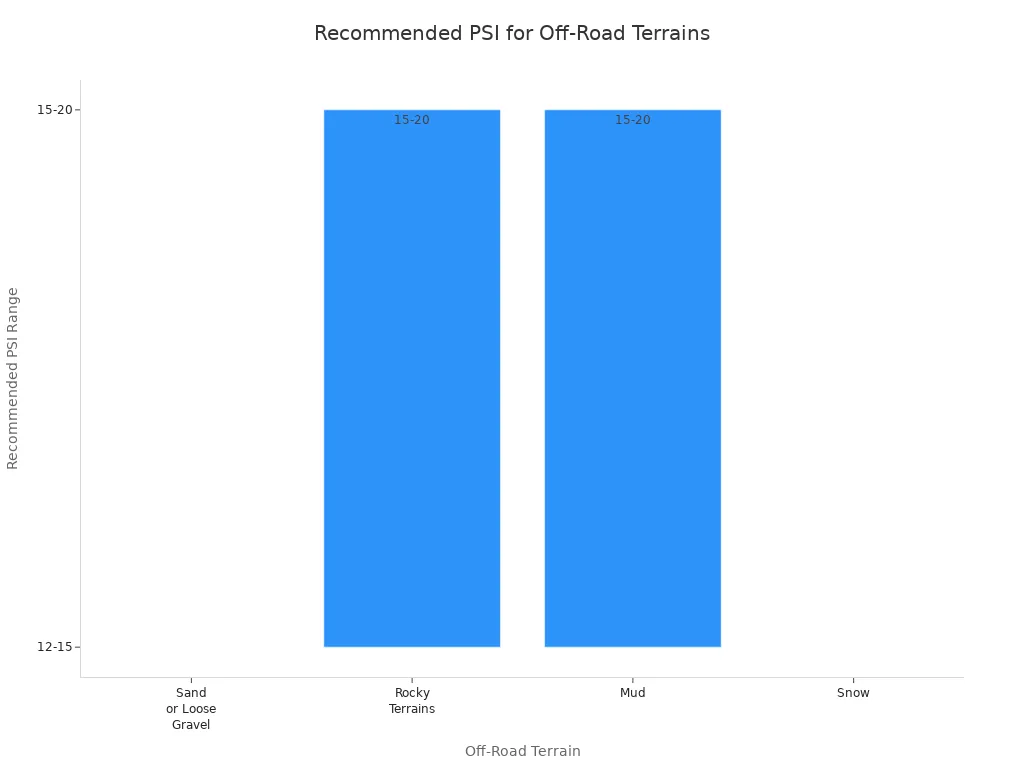
- Repeat the process for each tire. Make sure all your tires have the same pressure for even handling.
- Double-check each tire when you finish. Adjust if needed to get every tire to your target PSI.
Always use a reliable tire pressure gauge. This helps you avoid over-deflating and keeps your tires safe for your adventure.
When you finish airing down, your tires will be ready for the trail. You’ll have better grip, a smoother ride, and more control. Remember to re-inflate your tires before you get back on the road. Low pressure is great for off-roading, but you need full pressure for safe driving on pavement.
Finishing Up and Rechecking
You’ve let the air out of your tires and reached your target pressure. Now it’s time to finish up and make sure everything is just right before you hit the trail or road. This last step is important for your safety and for getting the best performance from your tires.
Here’s what you should do to wrap up the process:
Double-Check Tire Pressure
Grab your reliable tire pressure gauge. Check each tire again to make sure the pressure matches your target. Sometimes, air can escape a bit more than you expect, so a quick recheck helps you avoid surprises.Fine-Tune Each Tire
If you see that one tire is a little low, add a small amount of air. If another tire is a bit high, let out a tiny burst. You want all your tires to have the same pressure for even handling and control.Replace Valve Caps
Don’t forget to screw the valve caps back onto each tire. These little caps keep dirt and moisture out of the valve stem. They help your tires stay in good shape longer.Inspect Tire Condition
Take a moment to look at each tire. Check for cuts, bulges, or anything unusual. If you spot damage, fix it before you drive. A healthy tire gives you peace of mind on any adventure.Reinflate Before Pavement
When you finish your off-road fun, always reinflate your tires to the manufacturer’s recommended pressure. You can find this number in your vehicle manual or on the door placard. Driving on pavement with low tire pressure can cause poor handling and make your tires wear out faster.
Safety Tip: Always use a tire inflator with a built-in gauge when adding air. This helps you avoid over-inflating or under-inflating your tires.
Here’s a quick checklist to help you remember each step:
- Check the pressure on all tires with a gauge.
- Adjust air as needed to reach your target PSI.
- Securely replace all valve caps.
- Inspect each tire for visible damage.
- Reinstate the correct pressure before driving on paved roads.
If you follow these steps, you keep your tires safe and ready for any road. You also get the best grip, comfort, and control from your vehicle. Taking a few extra minutes to finish up and recheck your tires can make a big difference in your driving experience.
Common Mistakes When Airing Down and How to Avoid Them
When you head out for off-roading, airing down your tires can make a huge difference. You get better traction, a smoother ride, and your tires absorb bumps from rocks and roots. Still, some common mistakes can ruin your adventure or even put you in danger. Let’s look at the top errors and how you can avoid them.
Letting Out Too Much Air
You might think that dropping your tire pressure as low as possible gives you the best grip. That’s not true. If you let out too much air, your tire can unseat from the rim, especially when you turn hard or drive fast. Underinflated tires cause poor handling, increased fuel use, and faster wear. You also risk blowouts and losing control of your vehicle. Always check your tire pressure and keep it close to the manufacturer’s recommended level for off-roading. Most drivers air down to about two-thirds of the normal pressure and drive slowly. Never go below half the recommended pressure unless it’s an emergency.
Tip: Keep your speed under 15 mph when your tires are aired down. This helps prevent damage and keeps you safe.
Not Using a Pressure Gauge
Guessing your tire pressure is risky. Without a reliable gauge, you can’t know if your tires are ready for off-roading. You might end up with tires that are too soft or too hard. This leads to reduced grip, poor handling, and even safety problems. A good tire pressure gauge lets you make small, accurate changes. You want to check your tires before, during, and after airing down. This keeps your vehicle performing at its best.
- Always carry a pressure gauge in your off-roading kit.
- Check each tire in 2 PSI steps for the best results.
Forgetting to Reinflate Afterward
After off-roading, you need to bring your tires back to normal pressure. If you forget, your tires wear out faster and your vehicle handles poorly on pavement. Driving at highway speeds with aired-down tires can cause overheating, blowouts, and even legal trouble. Reinflate your tires as soon as you finish off-roading. This simple step keeps you safe and saves you money.
| Mistake | Consequence | How to Avoid |
|---|---|---|
| Letting out too much air | Tire damage, poor handling | Follow recommended PSI |
| Not using a pressure gauge | Unsafe, uneven tire pressure | Always use a gauge |
| Forgetting to reinflate | Increased wear, safety hazards | Reinflate before pavement |
Airing down is a smart move for off-roading, but only if you avoid these mistakes. Stay safe, protect your tires, and enjoy every adventure.
Ignoring Manufacturer Recommendations
You might feel tempted to set your own rules when it comes to tire pressure, especially if you’re eager to hit the trail or try something new. But ignoring what the manufacturer says about your tire can lead to big problems. The people who design your vehicle and your tire know exactly what works best for safety, performance, and durability. If you skip their advice, you risk damaging your tire, hurting your ride quality, or even putting yourself in danger.
Manufacturers give you clear guidelines for a reason. Here’s what you should always remember:
- Always follow the vehicle manufacturer’s recommended tire pressure for all-season tires.
- For winter tires, add 3 PSI to the usual recommendation. Cold weather makes tire pressure drop, so this keeps your tire at the right level.
- Tire pressure can drop about 1 PSI for every 10°F decrease in temperature. If it’s cold outside, check your tire before you drive.
- Use a reliable tire pressure gauge. Don’t guess—get the real number.
- Check your tire pressure regularly, at least once a month. Don’t forget the spare tire.
- Adjust your tire pressure if you’re carrying extra weight or if the weather changes a lot.
- Always check your tire when it’s cold for the most accurate reading.
- Underinflated tires make your vehicle handle poorly and use more fuel. Overinflated tires can be dangerous, especially when you turn.
- Stick to the recommended tire pressure for normal use and for full loads. Don’t go below or above unless the manufacturer says it’s safe.
If you ignore these tips, your tire might wear out faster, lose grip, or even blow out. You want your tire to last and keep you safe, so trust the experts. They’ve tested your tire in all kinds of conditions. When you follow their advice, you get the best balance of safety, comfort, and performance.
Remember: Your tire is the only thing between your vehicle and the road. Take care of it by following the rules set by the people who know it best.
Tips for Best Results When Using an Air Down Tool
Choosing the Right PSI for Your Activity
When you get ready for off-roading, picking the right PSI for your tire is key. You want to know how much to air down before you hit the trail. Experts say the best PSI depends on your vehicle’s weight, the type of tire you have, and the terrain you plan to cross. Softer ground, like sand or snow, needs lower tire pressure. This helps your tire spread out and grip the surface better. For sand, you might drop your tire pressure by about 5 psi. Rocky trails often need a bigger drop, sometimes up to 10 psi, to protect your tire from sharp rocks and give you more traction.
If you have larger tires, you can safely use lower pressures. Heavier vehicles or smaller wheels need a bit more air to keep the tire bead in place. Most off-roading fans stick to a range of 15-25 psi for the best balance of grip, comfort, and tire safety. Going too low can cause the tire to come off the rim or even blow out. Always use a good tire pressure gauge and your air down tool to check as you go. After your adventure, bring your tire back to the ideal tire pressure for pavement. This keeps your tire safe and helps with off-road performance.
Tip: Lower tire pressure gives you better traction and a smoother ride, but always drive slowly when your tires are aired down.
Keeping Your Tools Handy
You want your air down tool ready whenever you go off-roading. Storing your tool in its case or original box keeps it safe from dirt and damage. Use silica gel packs or anti-rust liners in your toolbox to stop moisture from causing rust. After each use, clean your tool with mild soap and water. Dry it well before putting it away. Check your tool for dents, cracks, or loose parts every time you use it.
Keep your storage area dry and cool. Avoid leaving your tool in hot or humid places. If you live in a humid area, a dehumidifier helps keep your tools in top shape. Organize your gear so you can grab your air down tool fast when you need it. A well-kept tool makes airing down your tire quick and easy.
- Store tools in cases or covered boxes.
- Use silica gel packs to fight moisture.
- Clean and dry tools after every use.
- Inspect for damage before and after off-roading.
- Keep your storage area dry and organized.
Checking Tire Condition Regularly
Before every off-roading trip, take a close look at your tire. Look for cuts, bulges, or worn spots. A damaged tire can fail when you air down, which can ruin your day or even cause an accident. Check the sidewalls and tread for any signs of trouble. If you see anything odd, fix it before you go off-roading.
After you finish, inspect your tire again. Off-roading can be tough on tires, so you want to catch problems early. Keeping your tire in good shape means you get better grip, more comfort, and a safer ride every time. Regular checks help you spot issues before they become big problems.
Safety Reminder: Always check your tire pressure and condition before and after every off-roading adventure.
Practicing Safe Airing Down Techniques
When you get ready for off-roading, safety should always come first. Practicing the right techniques helps you protect your vehicle and enjoy your adventure. Here’s how you can air down your tires safely every time you head out for off-roading:
- Park your vehicle on level ground. Stay away from traffic and make sure you use your parking brake. Place wheel chocks behind your tires for extra stability.
- Always use a reliable tire pressure gauge. This tool lets you check your tire pressure with accuracy. You want to know the exact PSI before and after airing down for off-roading.
- Use a quality air down tool or a tire deflator. If you need to release air manually, press the valve core gently. Take your time and never rush this step.
- Check your tire pressure often as you let air out. Make sure all your tires reach the same PSI. Even pressure gives you better control during off-roading.
- Avoid letting out too much air. If you go too low, your tire bead can unseat from the rim. This can cause a blowout and ruin your off-roading trip.
- After you finish, reinstall the valve cores tightly. This keeps air from leaking out while you drive.
- Take a short test drive on the trail. Stop and check your tire pressure again. Adjust if you need to. Off-roading can change your tire pressure, especially on rough ground. 8. Before you leave the trail and return to pavement, reinflate your tires to the manufacturer’s recommended PSI. This step keeps your tires safe and helps your vehicle handle well on the road.
Tip: Adjust your tire pressure based on your vehicle’s weight, the type of tire you use, and the terrain you plan to cross. Temperature changes can also affect your tire pressure, so check it often during off-roading.
Practicing these safe airing down techniques means you get the most out of every off-roading adventure. You protect your tires, keep your ride smooth, and stay ready for whatever the trail brings.
Fortune’s Commitment to Quality in Air Down Tools
Premium Materials and Manufacturing
When you pick up an air down tool from Fortune, you can feel the difference right away. Fortune uses only high-grade metals and advanced polymers in every tool. These materials make your tool strong and long-lasting. You do not have to worry about your tool breaking or wearing out quickly. Here’s what makes these materials special:
- High-grade metals stand up to tough jobs and resist bending or cracking.
- Advanced polymers keep the tool lightweight but still very strong.
- Precision components make sure every part fits and works perfectly.
- Rigorous manufacturing steps add even more strength and reliability.
You get a tool that handles demanding use, whether you are on a rocky trail or in your garage. Because these materials last longer, you save money over time. You will not need to replace your tool as often, and you spend less on repairs.
Strict Quality Control and Testing
Fortune takes quality seriously. Every air down tool goes through strict checks before it reaches you. Skilled engineers and technicians watch each step of the process. They test every tool for leaks, strength, and accuracy. If a tool does not meet Fortune’s high standards, it does not leave the factory.
You can trust that your tool will work right every time. Fortune’s team uses advanced machines and hands-on inspections to catch even the smallest problems. This careful testing means you get a tool you can count on, no matter where your adventure takes you.
Global Support and Service
Fortune supports you wherever you go. The company has offices and warehouses in North America and China, so you get fast help and quick shipping. You can reach out for support, repairs, or answers to your questions. Here’s a look at the support you can expect:
| Service Type | Description |
|---|---|
| Service Centers | Get repairs and maintenance at locations around the world. |
| Product Registration | Register your tool for warranty and support. |
| Warranty | Enjoy global warranty coverage for peace of mind. |
| Technical Documents | Access manuals and guides for easy troubleshooting. |
| Contact Options | Reach Fortune by phone, email, or online for quick help. |
You also get training and product support, just like top brands offer. Fortune’s team helps you use your tool the right way and keeps you ready for any job. With Fortune, you always have someone on your side, no matter where your journey takes you.
You can make tire pressure adjustment quick and safe with an air down tool. Just follow the steps, and you’ll get better traction and a smoother ride every time. Choose a reliable tool from Fortune for top results.
- Check your tire pressure before and after airing down
- Use your air down tool for easy control
- Always follow safety tips
Remember: Quality tools help you enjoy every adventure with confidence!
FAQ
How do I know the right PSI for off-roading?
You can check your vehicle manual or ask your tire manufacturer. Most drivers use 15–25 PSI for sand or rocky trails. Always use a tire pressure gauge to get an exact reading. Lower PSI gives you better grip, but never go below half the recommended pressure.
Can I use an air down tool on any tire?
Yes, you can use an air down tool on most tires with standard valve stems. If your tire has a specialty valve, check the tool’s compatibility first. Most off-road vehicles and trucks use standard valves, so you’re good to go.
How long does it take to air down all four tires?
You can air down all four tires in about 5–10 minutes with a quality tool. Automatic deflators work faster. Manual tools take a bit longer. Always check each tire with a gauge for accuracy.
Do I need to re-inflate my tires after off-roading?
Absolutely! Driving on pavement with low tire pressure can damage your tires and make steering harder. Use an air compressor or visit a service station to bring your tires back to the recommended PSI before you hit the road.
What should I do if my air down tool stops working?
First, check for dirt or debris in the tool. Clean it with mild soap and water. If it still doesn’t work, contact the manufacturer or visit a service center. Fortune offers global support and warranty service for quick help.
